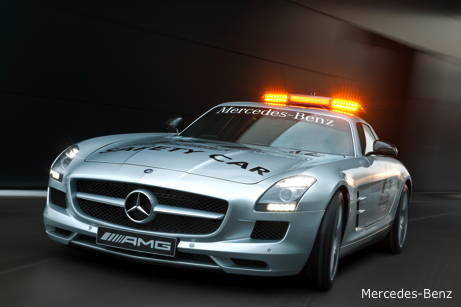
Safety cars are used to slow the field in a race to a controlled speed during extremely wet conditions or while marshals work at the scene of an accident. Safety cars are used in Formula 1, the Le Mans Series, Indycar and many other forms of racing.
F1 cars are, to a certain degree, more dangerous and more vulnerable the slower they go. Designed for the high speeds of racing conditions, they work badly when speeds are reduced. The carbon brakes, designed to work at 650˚C, cool down and once outside their optimum temperature range they stop working effectively, so braking distances increase. The rubber compound used for the tyre treads also drops outside its optimum range, and as the tyre cools it loses pressure, further reducing grip. The loss of tyre pressure also reduces the cars' ride height by a few millimetres, disturbing the aerodynamic balance and possibly allowing the cars to bottom out over bumps – leading to unpredictable handling.
And there's a reliability issue, too: F1 car cooling systems are designed to be fed massive amounts of cooling air. Unlike a road car they have no fan assistance for low-speed running, so if the safety car laps too slowly there's a chance the F1 cars can overheat.
So the safety car has to be able to lap fast enough to keep the F1 cars operating effectively, yet it can't be a racing car: a F1 car takes a couple of minutes to start and warm up before it can be driven, but the safety car has to be able to give maximum performance in seconds, at a moment's notice. It must also be able to run safely in any conditions, and for any required period: at the Japanese GP in 2007 Safety Car driver Bernd Mayländer was on track for 20 laps of heavy rain. So a road car – a very, very quick road car – is the only alternative.
From 2010 the F1 Safety Car is a 571bhp Mercedes-Benz SLS AMG which can accelerate from 0-100km/h in 3.8 seconds, and go on to a top speed likely to nudge 200mph.
Though the SLS safety car is all but standard mechanically – the only change is a louder and freer-flowing rear silencer – there are some obvious visual differences from the standard car. Safety car graphics apart, the most obvious is the essential light bar, mounted on a carbon-fibre hoop which has been shaped to optimise air flow over the roof and down to a rear aerofoil, which pops up automatically above 120km/h (75mph) to kill rear-end aerodynamic lift.
The lights system has two central green lights which are illuminated when the safety car joins the field. In a change to previous procedures the safety car will then pass the racing cars in front of it, until it takes up a position ahead of the leading F1 car. The outer orange flashing lights are then switched on to indicate that no further overtaking is allowed.
The lights are controlled by coloured switches on the SLS' carbon fibre centre console, which also incorporates radio controls and a monitor showing the view of a camera mounted by the car's rear number plate. An additional interior rear-view mirror is also fitted so that co-driver Pete Tibbett can watch the cars behind the safety car.
In addition to the two SLS AMG safety cars (one on duty, plus a replacement) Mercedes-Benz will supply two C63AMG estates to act as Medical Car. This will be driven by Dutchman Alan van der Merwe, with F1 doctor Gary Hartstein as his passenger.
